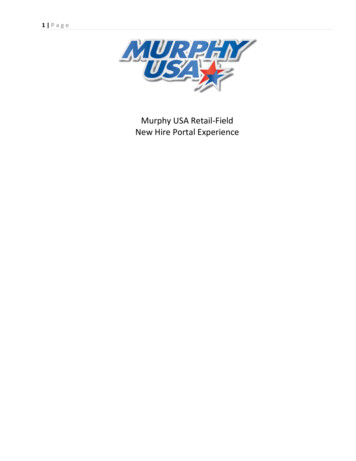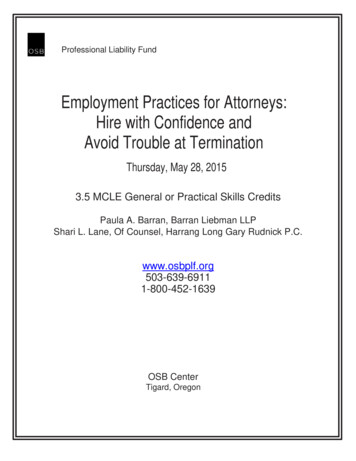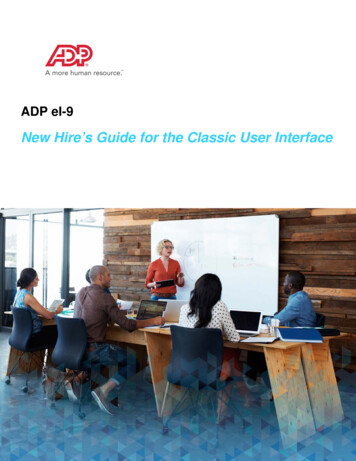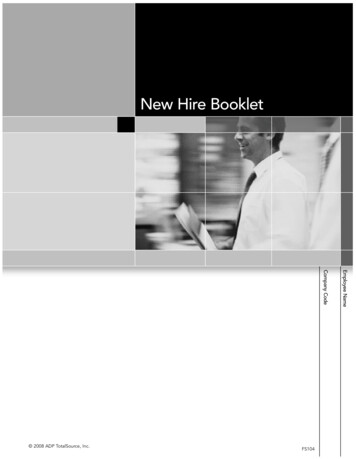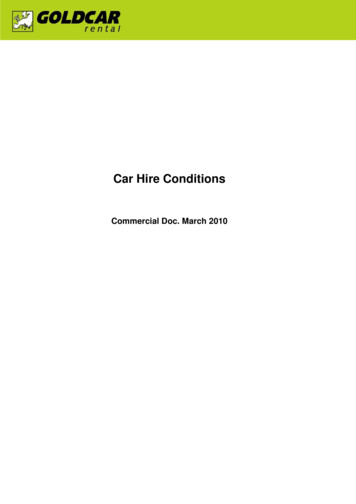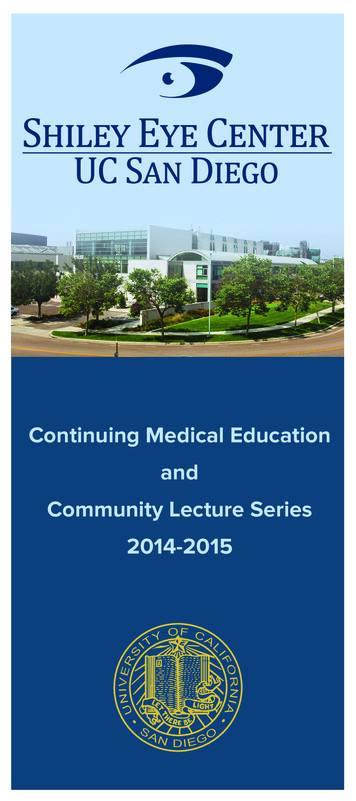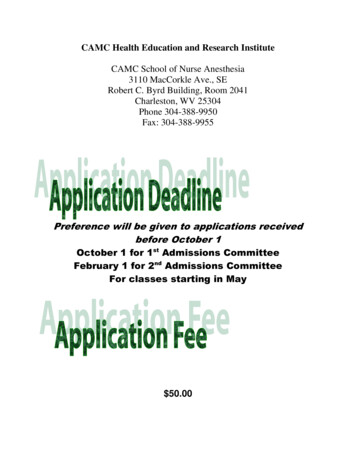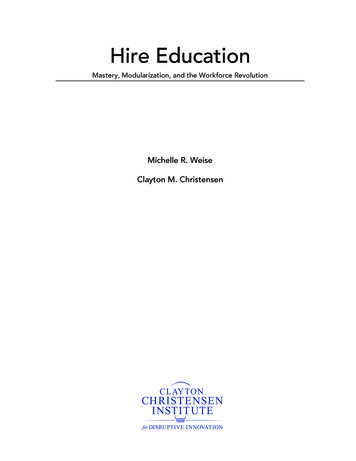
Transcription
Hire EducationMastery, Modularization, and the Workforce RevolutionMichelle R. WeiseClayton M. Christensen
Copyright 2014 Clayton Christensen Institute for Disruptive InnovationAll rights reserved.ISBN: 1500553123ISBN-13: 978-1500553128i
Hire EducationTABLE OF CONTENTS123456ABCHAPTERSIntroduction: Got Skills?Disruptive Innovation and Academic InertiaJobs To Be Done: The Shifting Value Proposition of CollegeThe Core of Competency-Based EducationOnline Competency-Based Education: Mastery and ModularizationA New Value Network: Industry-Validated Learning ExperiencesCollege DisruptedEpilogue: Education and Equalityiii191114273034APPENDICESShifts in Public Policy: Major DevelopmentsDescriptions of InnovatorsWestern Governors UniversityUniversityNow’s Patten UniversityNorthern Arizona University’s Personalized LearningUniversity of Wisconsin’s UW FlexSouthern New Hampshire University’s College for AmericaCapella University’s FlexPathBrandman University’s BBA373838383940424343NOTES46ii
Hire EducationINTRODUCTION:GOT SKILLS?The economic urgency around higher education is undeniable: the price of tuition hassoared; student loan debt now exceeds 1 trillion and is greater than credit card debt;the dollars available from government sources for colleges are expected to shrink inthe years to come; and the costs for traditional institutions to stay competitivecontinue to rise.At the same time, more education does not necessarily lead to betteroutcomes.1 Employers are demanding more academic credentials for every kind of jobyet are at the same time increasingly vocal about their dissatisfaction with the variancein quality of degree holders.2 The signaling effect of a college degree appears to bean imprecise encapsulation of one’s skills for the knowledge economy of the times.McKinsey analysts estimate that the number of skillsets needed in the workforce hasincreased rapidly from 178 in September 2009 to 924 in June 2012.3Students themselves are demanding more direct connections with employers:87.9 percent of college freshmen cited getting a better job as a vital reason forpursuing a college degree in the 2012 University of California Los Angeles’ HigherEducation Research Institute’s “American Freshman Survey”—approximately 17percentage points higher than in the same survey question in 2006;4 a survey of theU.S. public by Gallup and the Lumina Foundation confirmed similarly high numbers.5“Learning and work are becoming inseparable,” argued the authors of a report fromthe Institute for Public Policy Research, “indeed one could argue that this is preciselywhat it means to have a knowledge economy or a learning society. It follows that ifwork is becoming learning, then learning needs to become work—and universitiesneed to become alive to the possibilities.”6Even the demographics of students seeking postsecondary education areshifting. The National Center for Education Statistics projects that by 2020, 42 percentof all college students will be 25 years of age or older.7 More working adults arebecoming responsible for actively honing and developing new skills for the newtechnologies and jobs emerging on a day-to-day basis.Despite these trends, few universities or colleges see the need to adapt to thesurge in demand of skillsets in the workforce. Distancing themselves from the notionof vocational training, institutions remain wary of aligning their programs and majorsiii
Hire Educationto the needs of today’s rapidly evolving labor market. At the same time, the businessmodels of most traditional schools make them structurally incapable of responding tochanges in the markets that they serve. Therefore, whether institutions like it or not,students are inevitably beginning to question the return on their higher educationinvestments because the costs of a college degree continue to rise and the gulfcontinues to widen between degree holders and the jobs available today.Who will attend to the skills gap and create stronger linkages to theworkforce? This book illuminates the great disruptive potential of online competencybased education. Workforce training, competency-based learning, and online learningare clearly not new phenomena, but online competency-based education isrevolutionary because it marks the critical convergence of multiple vectors: the rightlearning model, the right technologies, the right customers, and the right businessmodel. In contrast to other recent trends in higher education, particularly thetremendous fanfare around massive open online courses (MOOCs), onlinecompetency-based education stands out as the innovation most likely to disrupthigher education. As traditional institutions struggle to innovate from within and othereducation technology vendors attempt to plug and play into the existing system,online competency-based providers release learning from the constraints of theacademy. By breaking down learning into competencies—not by courses or evensubject matter—these providers can cost-effectively combine modules of learning intopathways that are agile and adaptable to the changing labor market.The fusion of modularization with mastery-based learning is the key tounderstanding how these providers can build a multitude of stackable credentials orprograms for a wide variety of industries, scale them, and simultaneously drive downthe cost of educating students for the opportunities at hand. These programs target agrowing set of students who are looking for a different value proposition from highereducation—one that centers on targeted and specific learning outcomes, tailoredsupport, as well as identifiable skillsets that are portable and meaningful to employers.Moreover, they underscore the valuable role that employers can play in postsecondaryeducation by creating a whole new value network that connects students directly withemployers.An examination of online competency-based education unveils the tectonicshifts to come in higher education. Over time, the industry-validated experiences thatemerge from the strong partnerships between online competency-based providersand employers will ultimately have the power to override the importance of collegerankings and accreditation.***iv
Hire Education Chapter 1 uses the theory of disruptive innovation to illustrate how the inertiaof the academy inevitably makes way for upstart disruptors—online,competency-based educational programs—to seize a market of untappedconnections between learning and work. Chapter 2 illuminates how students are looking for a new value propositionfrom higher education. Chapter 3 outlines the core—both online and offline—of competency-basededucation in order to show in the following chapter why online competencybased education holds particular appeal for the growing segment of thecollege-going population described in Chapter 2. Chapter 4 describes how online competency-based education providers—unfettered by the constraints of the academy—are uniquely positioned to alignlearning to workforce needs. Chapter 5 reveals the transformative power of a new value network thatemerges from industry-validated learning experiences. Chapter 6 predicts the long-term impact that online competency-basededucation will have on the postsecondary system as a whole.v
1DISRUPTIVE INNOVATION AND ACADEMIC INERTIAWhen it comes to higher education, there is a lot of buzz about online education’spotential disruption of traditional postsecondary education. Unfortunately, the word“disruption” is bandied about so frequently that most audiences misunderstand theterm or imprecisely frame the threat.8A disruptive innovation explains why it is so difficult for organizations tosustain success.9 In business, companies tend to innovate faster than theircustomers’ needs evolve. Most end up producing products or services that are toosophisticated, too expensive, or too complicated for many customers in theirmarket. They pursue these sustaining innovations because this is what hashistorically helped them succeed: by charging the highest prices to their mostdemanding and sophisticated customers, companies achieve greater profitability.Inevitably, though, they overshoot the performance needs of their customers and, atthe same time, unwittingly open the door to disruptive innovations at the bottom ofthe market. A disruptive innovation gains traction by initially offering simpler, moreaffordable, and more convenient products and services to nonconsumers, people forwhom the alternative is nothing at all.1
Hire EducationUnderstanding the nonconsumer in higher educationMany people who are busy predicting the potential disruption of higher educationmiss that the process of disruption began as early as 1989 when the University ofPhoenix launched its fully online university. At that point, online technology hadbecome reliable enough to help these universities scale the teaching and learningprocess and cater to nonconsumers of higher education—students for whom theiralternative to an online higher education was nothing at all. Online technology wasthe technological enabler needed to enable disruption in the higher educationindustry.10Some observers, however, tend to dismiss the idea that these learningpathways were disruptive by disparaging the quality of these educationalexperiences.11 A disruptive innovation’s first, simple application, however, is often ofa lower quality according to traditional metrics of performance. Over time, itimproves gradually to become good enough to take on a larger share of the marketby solving more complicated problems.In this particular case, regardless of the questionable quality of this onlinelearning experience, students flocked to these fully online universities. This firstwave of online education presented working adults with a new value propositionaround flexibility and convenience by allowing many to avoid the opportunity costsof quitting their jobs. Those who enrolled preferred having a just-good-enougheducational experience to nothing at all. Students were willing to pay a premiumprice for a functional, flexible, and convenient source of learning. Unfortunately,however, these fully online universities were never able to fill satisfactorily the gapbetween students and the workforce because they began chasing Title IV money ina federal financial aid system ripe for gaming. Their march up-market toward a fulltransformation of the higher education industry never came to pass, as the studentloan crisis—not to mention some of the predatory recruiting practices of leading forprofits—came to the public’s attention. Nevertheless, even before these revelationscame to light, a second wave of online programs began to emerge, that competedon price, which, according to the Parthenon Group, is increasingly displacingconvenience as the most important factor for many students in attending college.12Unlike the University of Phoenix, which charges 570 per credit hour, AmericanMilitary University (AMU), a low-cost, for-profit institution, which operates in theAmerican Public University System (APUS) along with American Public University,charges 250 per credit hour. A more recent wave of disruptors that includesSouthern New Hampshire University’s College for America (CfA) andUniversityNow’s Patten University (UNow) is even lower-priced and incorporatesonline competency-based learning. We explain the cost advantage of theseparticular programs later in the book.Still, many observers maintain that that these learning pathways are notdisruptive by pointing out how most traditional institutions remain unscathed bythese supposed disruptors.13 The emergence of disruptive innovations, however,does not entail the immediate downfall of established organizations. Disruptive2
Hire Educationinnovations do not compete directly at the outset with the leaders of the industry. Infact, the theory predicts that head-on competition with incumbents most oftenresults in failure.Traditional institutions have continued to thrive financially because the initialwave of disruptive entrants targeted a completely separate market. Often referredto as nontraditional students, this market is comprised of people who are oftenolder than the typical 18 to 22-year-old student population, are not enrolled fulltime, do not live on campus, and have work, family, or other responsibilities that caninterfere with the successful completion of their learning objectives. Oddly, thenontraditional student has become the new normal, as somewhere around 71percent of the college-going students in America now fall under this misnomer.14Most institutions are aware that the demographic of college-going studentsis shifting and that students’ priorities are likewise evolving. Nevertheless, just as inevery tale of disruption, the established organization is hamstrung, as it sees thedisruptive entrant making its way into the market but cannot do anything butdevelop sustaining innovations. The business model of the incumbent’s organizationinevitably steers its leaders to invest in improvements that affect only its existing ormost desirable or demanding customers.Particularly over the last few decades, traditional institutions have investedsubstantial resources into competing with their fellow institutions. In a race to moveup in the rankings—similar to what we see in industry after industry that hasexperienced disruption—most universities have focused their efforts on sustaininginnovations: increasing inputs, such as enhanced technology in teaching, improvedclassrooms, more faculty research, and better residence halls and dining facilities.There are various labels for this up-market pull in higher education. EconomistGordon Winston describes it as an “arms race.”15 Kaplan CEO Andrew Rosen calls it“Harvard envy”16: the desire of universities to emulate Harvard’s prestige andexclusivity by “spending far too much time and energy trying to be somethingthey’re not.”17 As a report from the National Bureau of Economic Researchexplained: “[F]or many institutions, demand-side market pressure may not compelinvestment in academic quality, but rather in consumption amenities.”18Such amenities add significant cost,19 and although they serve well thetraditional, campus-based students, these sustaining innovations do not helpnonconsumers of higher education. Traditional institutions inevitably over-serveadult learners looking to advance their careers with amenities that they do not need.These students seek affordable and flexible learning pathways that allow for fastertimes to degree completion—not to mention the ability to pick and choose theireducation from different institutions and outlets. They are less willing to pay forwhat they will never use. Furthermore, looking ahead, these amenities mayovershoot what traditional, campus-based students are willing or able to pay forthem, which would create more headroom for disruptive innovations to grow.3
Hire EducationAcademic inertiaUnfortunately, established institutions cannot help but develop sustaininginnovations that carry them up-market because, like most businesses, they arecomprised of four basic and deeply interdependent components.Figure 1. The elements of a business modelAs depicted in Figure 1, the starting point in the creation of any successfulorganization’s business model is its value proposition. For a liberal arts college, forinstance, that value proposition might be to offer excellent teaching in small,intimate settings. Institutional leaders then put in place a set of resources—facultymembers in different departments, dollars spent per student, buildings, labs, andother capital expenditures—required to deliver that value proposition. In repeatedlyworking toward that goal, processes, such as course enrollment, studentrecruitment, financial aid packaging, tenure promotion, accreditation management,and fundraising, coalesce that define how resources are combined to deliver thevalue proposition. This very complex set of elements goes through multipleiterations and cycles of change before a stable revenue formula emerges, whichdepends on state and federal subsidies, tuition, and endowment funds, andsupports the resources and processes.Such stability is difficult to achieve. In fact, once the four interdependentcomponents come together to deliver education in a sustainable manner, thebusiness model then begins to work in reverse. Instead of the value propositiondriving the resources, processes, and revenue formula, the business model begins todictate the sorts of value propositions the organization can or cannot deliver.20Because this balance is so challenging to get right, the business model of traditionalinstitutions cannot evolve easily, particularly in the face of rapid innovation. As aresult, disruptive innovations generally appear unattractive to the organization4
Hire Educationbecause they are fundamentally at odds with the business model—valueproposition, resources, processes, and revenue formula—of the college oruniversity.21Another way to capture the incompatibility of a disruptive innovation withinthe business model of an established university is to consider the forces thatencumber the legislative process. Even if a member of Congress were to identifyand envision an innovative solution to a pressing societal problem, the introductionof a bill can evoke opposition from different constituencies, such as labor unions, theChamber of Commerce, or a powerful senator threatening to block the legislation—all of whom must be appeased in some way. As a result, in order to garner enoughvotes to be enshrined as law, the bill is modified to address their concerns and fitthe interests of those with powerful votes. The result is a final bill that only faintlyresembles the original innovative solution.These same forces are at work in every company and every organization. Thepowerful forces that emerge from the balancing act of Figure 1 inevitably take everynew innovative proposal and shape it into a sustaining innovation—one thatconforms to the existing organization’s own business model. This is a core reasonwhy traditional institutions are at a disadvantage when disruptive innovationsemerge; they are asymmetrically motivated to pursue sustaining innovations only—not disruptive ones.A clear example of asymmetric motivation can be found in the computerindustry. When the first personal computers were being commoditized, DigitalEquipment Corporation (DEC) was in the prime of its life and building better andmore expensive minicomputers for their best customers. For the first 10 years, thepersonal computer from Apple simply could not perform well enough for DEC’scustomers; in fact, it was marketed as toy for children. The two companies sold tocompletely different markets, and it simply did not make sense for DEC to pursuethe personal computer market. DEC’s gross margins were in excess of 100,000 perunit, whereas the gross margins that could be earned from selling a personalcomputer were less than 1,000 per unit. Over time, however, as personalcomputers evolved, they became good enough to do much of what mainframes andminicomputers could do and ultimately disrupted DEC. The only way DEC couldhave avoided collapse is if it had set up a new autonomous business unit with newcost structures, prioritization criteria, and values.Organizations cannot disrupt themselves. They cannot transform thebusiness models of their existing business units into disruptive growth businessesbecause they will naturally prioritize innovations that promise improved profitmargins relative to their current cost structure. Companies such as Hewlett-Packard,Johnson & Johnson, and General Electric have managed to survive the last fewdecades by creating new, smaller, autonomous disruptive business units andshutting down or selling off mature ones that had reached the feasible end of theirsustaining-technology trajectories.5
Hire EducationThe options for traditional institution
American Public University System (APUS) along with American Public University, charges 250 per credit hour. A more recent wave of disruptors that includes Southern New Hampshire University’s College for America (CfA) and UniversityNow’s Patten University (UNow) is even lower-

